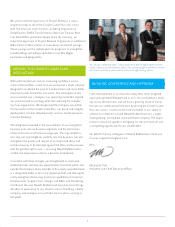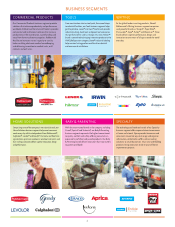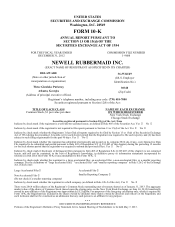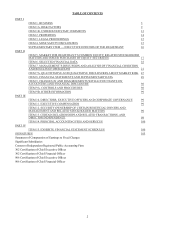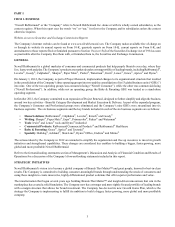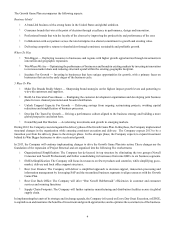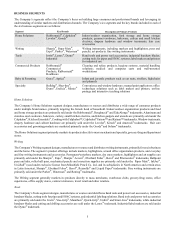Graco 2012 Annual Report Download - page 14
Download and view the complete annual report
Please find page 14 of the 2012 Graco annual report below. You can navigate through the pages in the report by either clicking on the pages listed below, or by using the keyword search tool below to find specific information within the annual report.8
in 2013. The Company has reduced the volume of its resin purchases through rationalizing and exiting product lines. On an
annualized basis, commodities consumed as raw materials generally represent approximately 10% to 15% of annual cost of products
sold, with no single type of commodity representing more than 10% of cost of products sold.
The Company also relies on third-party manufacturers as a source for finished goods. In a limited number of cases, a single
manufacturer or a limited number of manufacturers may supply substantially all of the finished goods for a product line. In
particular, certain businesses within the Baby & Parenting and Home Solutions segments rely on third-party manufacturers for
substantially all of their products.
See Management’s Discussion and Analysis of Financial Condition and Results of Operations for further discussion.
Backlog
The dollar value of unshipped factory orders is not material.
Seasonal Variations
Sales of the Company’s products tend to be seasonal, with sales and operating income in the first quarter generally lower than any
other quarter during the year, driven principally by reduced volume and the mix of products sold in the first quarter. Historically,
the Company has earned more than 60% of its annual operating income during the second and third quarters of the year. The
seasonality of the Company’s sales volume, combined with the accounting for fixed costs such as depreciation, amortization, rent,
personnel costs and interest expense, impacts the Company’s results on a quarterly basis. In addition, the Company has historically
generated more than 60% of its operating cash flow in the second half of the year due to seasonal variations in operating results,
the timing of annual performance-based compensation payments and customer rebates, and credit terms provided to customers.
Patents and Trademarks
The Company has many patents, trademarks, brand names and trade names that are, in the aggregate, important to its business.
The Company’s most significant registered trademarks are “Rubbermaid®,” “Graco®,” “Aprica®,” “Levolor®,” “Calphalon®,”
“Goody®,” “Sharpie®,” “Paper Mate®,” “Dymo®,” “Parker®,” “Waterman®,” “Irwin®” and “Lenox®.”
Customers/Competition
The Company’s principal customers are large mass merchandisers, such as discount stores, home centers, warehouse clubs, office
superstores, commercial distributors and e-commerce companies. The rapid growth of large mass merchandisers, together with
changes in consumer shopping patterns, has contributed to a significant consolidation of the consumer products retail industry
and dominant multi-category retailers and e-commerce companies that have strong negotiating power with suppliers. This
environment may limit the Company’s ability to recover cost increases through selling prices.
Current trends among retailers and e-commerce companies include fostering high levels of competition among suppliers,
demanding innovative new products and requiring suppliers to maintain or reduce product prices and deliver products with shorter
lead times. Other trends, in the absence of a strong new product development effort or strong end-user brands, are for retailers
and e-commerce companies to import generic products directly from foreign sources and to source and sell products, under their
own private label brands, which compete with products of the Company. The combination of these market influences has created
an intensely competitive environment in which the Company’s principal customers continuously evaluate which product suppliers
to use, resulting in downward pricing pressures and the need for big, consumer-meaningful brands, the ongoing introduction and
commercialization of innovative new products, continuing improvements in category management and customer service, and the
maintenance of strong relationships with large, high-volume purchasers. The Company competes with numerous manufacturers
and distributors of consumer products, many of which are large and well-established.
The Company’s principal methods of meeting its competitive challenges are creating and maintaining consumer-meaningful brands
and differentiated products that deliver superior value and performance; delivering superior customer service and consistent on-
time delivery; producing and procuring products at a competitive cost; and experienced management.
The Company has also positioned itself to respond to the competitive challenges in the retail environment by developing strong
relationships with large, high-volume purchasers. The Company markets its strong multi-product offering through virtually every
category of high-volume retailer, including discount, drug, grocery and variety chains; warehouse clubs; department, hardware
and specialty stores; home centers; office superstores; and contract stationers. The Company’s largest customer, Wal-Mart (which
includes Sam’s Club), accounted for approximately 10.8% of net sales in 2012, across substantially all segments. The Company’s
top-ten customers in 2012 included (in alphabetical order): Bed Bath & Beyond, Lowe’s, Office Depot, OfficeMax, Staples,
Target, The Home Depot, Toys ‘R’ Us, United Stationers and Wal-Mart.



